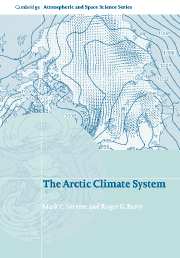Book contents
- Frontmatter
- Contents
- Preface page
- Acknowledgements
- List of Abbreviations
- 1 The evolution of knowledge about the Arctic and its climate
- 2 Physical characteristics and basic climatic features
- 3 The basic atmospheric heat budget
- 4 The atmospheric circulation
- 5 The surface energy budget
- 6 Precipitation, net precipitation and river discharge
- 7 Arctic ocean–sea ice–climate interactions
- 8 Climate regimes of the arctic
- 9 Modeling the arctic climate system
- 10 Arctic paleoclimates
- 11 Recent climate variability, trends and the future
- References
- List of selected websites
- Index
- Plate Section
6 - Precipitation, net precipitation and river discharge
Published online by Cambridge University Press: 10 August 2009
- Frontmatter
- Contents
- Preface page
- Acknowledgements
- List of Abbreviations
- 1 The evolution of knowledge about the Arctic and its climate
- 2 Physical characteristics and basic climatic features
- 3 The basic atmospheric heat budget
- 4 The atmospheric circulation
- 5 The surface energy budget
- 6 Precipitation, net precipitation and river discharge
- 7 Arctic ocean–sea ice–climate interactions
- 8 Climate regimes of the arctic
- 9 Modeling the arctic climate system
- 10 Arctic paleoclimates
- 11 Recent climate variability, trends and the future
- References
- List of selected websites
- Index
- Plate Section
Summary
Overview
One of the keys to understanding the Arctic climate system is the determination of freshwater transfers. As introduced in Chapter 2, the Arctic Ocean is characterized by a relatively fresh surface layer, primarily maintained, in relative order of importance, by river discharge, the import of low salinity seawater through the Bering Strait, and net precipitation over the Ocean itself. This freshwater surface layer allows sea ice to form readily. In turn, the major exports of freshwater are the ice and water fluxes exiting Fram Strait and through the Canadian Arctic Archipelago. “Following the water” through the atmospheric, terrestrial and oceanic branches of the Arctic hydrologic cycle, and assessing links between these fluxes and the global climate system is a vibrant area of research. But the problem cannot be tackled all at once. Here, we focus on a large, yet digestible piece – precipitation, net precipitation and river discharge to the Arctic Ocean. Aspects of the ocean branch will be examined as part of Chapter 7. One of the important issues reviewed there is the link between the Fram Strait ice and water flux and deep water formation in the North Atlantic.
As is evident in Figure 2.25, mean annual precipitation over the Arctic ranges widely. There is also strong seasonality. Precipitation over the Atlantic sector exhibits a general maximum during the winter half of the year while elsewhere a warm season maximum is the rule.
- Type
- Chapter
- Information
- The Arctic Climate System , pp. 147 - 176Publisher: Cambridge University PressPrint publication year: 2005



